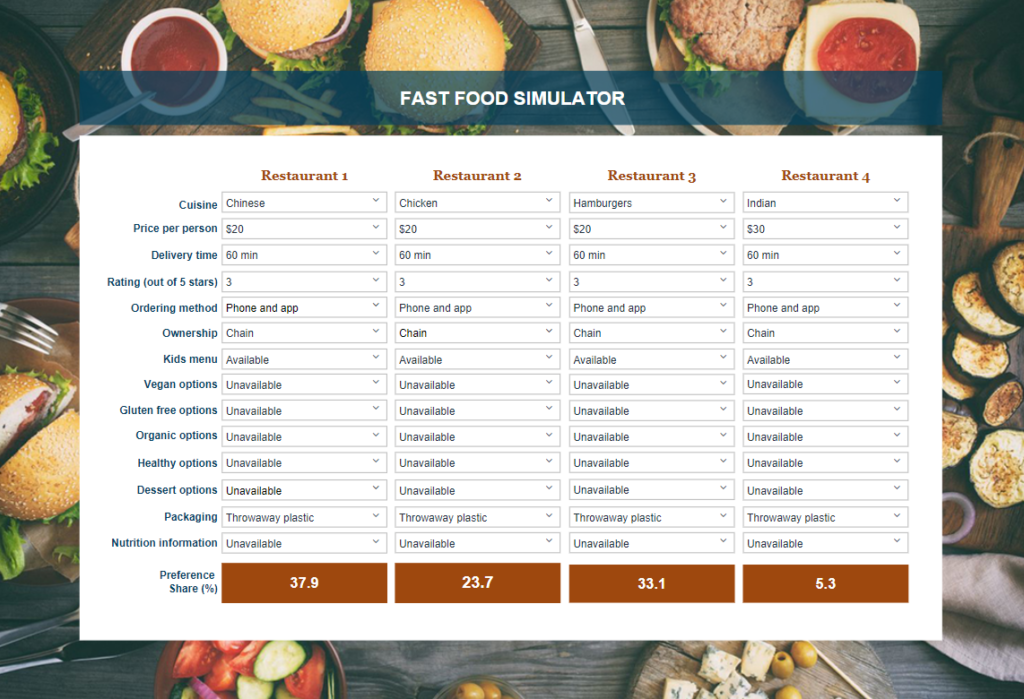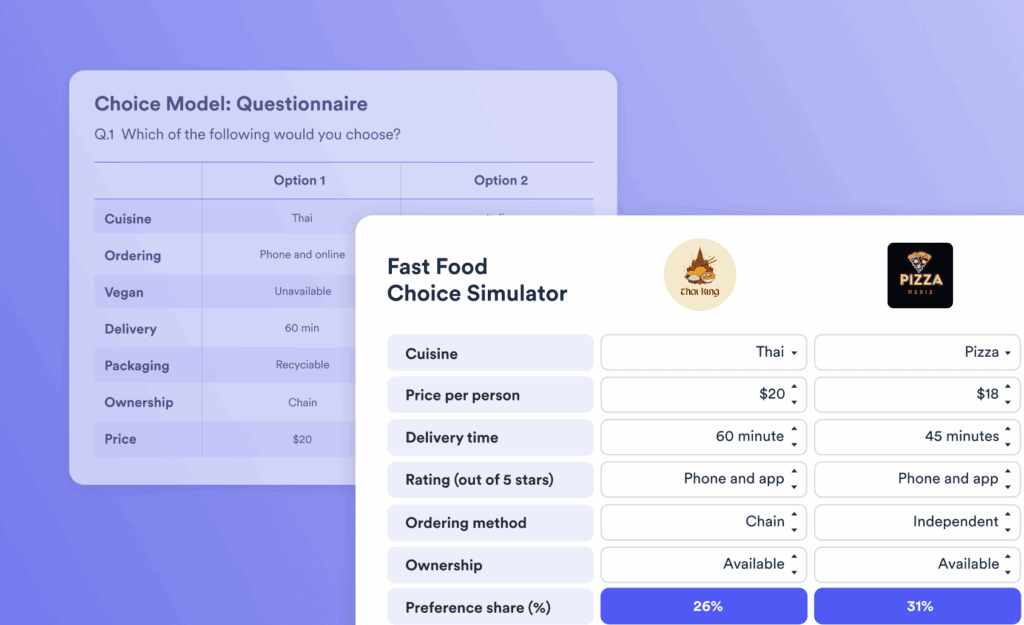Displayr is the world's only complete choice modeling software. You can use it to generate experimental designs, analyze both experimental and real-world data, build online simulators, and create reports. Better yet, if you change anything, everything will update automatically.
What is Discrete Choice Analysis in Market Research?
We all make hundreds of choices and decisions, big and small, each and every day. Many of those choices involve picking between brands, products, or services and consist of numerous tiny factors that influence our decisions. Marketers, product designers, companies, retailers, and many others naturally want to understand what drives these choices.
Choice modeling is a powerful analytic tool used to predict the probability of individuals making a particular choice given the different features of the available options. It is often used to determine willingness to pay for goods and services, and important pricing and marketing decisions. It can also be used to predict market share and demand for future products. Choice modeling is also called conjoint choice modeling, discrete choice analysis, and conditional logistic regression.
Discrete Choice Modeling vs Conjoint Analysis
Discrete choice modeling (DCM) and conjoint analysis are closely linked, but not identical. Each aims for the same thing - that is, understanding what drives decisions - but takes a different approach.
Conjoint analysis asks people to rate or rank product variations to reveal how much they value each feature. Discrete choice modeling, a more advanced form of conjoint, skips the ratings and forces a real decision: pick one option from a set. That single change makes the method far more realistic, letting researchers model the probability that someone will choose one product over another.
This means that all discrete choice modeling is technically a form of conjoint analysis. However, not all conjoint analysis is DCM, with the main difference being that DCM focuses on actual choices, giving researchers a sharper view of how people really behave in the market.
How Do Choice Models in Market Research Work?
There are two types of choice models. You can model real-world data. Or, you can create experiments with a series of hypothetical choice tasks that are designed to show the behavior and preferences of consumers. Respondents are given a set of questions or choice tasks with the same number of alternatives. Within these alternatives are different attributes, and each attribute has different levels. For example, if price is an attribute, different values would be different levels. This set of questions is a version, and respondents are shown multiple versions and asked to select their preference.
Choosing Discrete Choice Modeling Software
Displayr is the only complete data analysis platform. Created by experts in the field of discrete choice modeling, Displayr is modern and designed to be easy to use. You can build online choice simulators, while Displayr uses the most advanced methods to generate the best choice tasks. Oh, and did we mention it's complete? That means you get to spend less (as in none!) time shuffling between and paying for different products between SPSS, R, Q, and Sawtooth.
Displayr Features for Discrete Choice Modeling
- Experimental designs: random, efficient, priors, partial profile
- Models: MNL, latent class, HB, multi-class HB, random parameters logit, covariates
- Simulators: online with client logins
- Reporting: a full suite of visualizations + export to PowerPoint and Excel

What is discrete choice modeling?
Discrete choice modeling is a market research method used to understand how people make decisions between competing products or services. It analyzes the trade-offs consumers make between attributes such as price, brand, and features to predict which option they are most likely to choose. The results help businesses identify what truly drives customer preference and purchase behavior.
How does discrete choice modeling differ from conjoint analysis?
Conjoint analysis asks people to rate or rank product variations, while discrete choice modeling asks them to choose one option from a set, mirroring real decisions. That difference makes DCM more realistic and enables estimation of the likelihood that consumers will pick a specific alternative when confronted with multiple options.
What is a discrete choice experiment (DCE)?
A discrete choice experiment is the survey format used to collect data for discrete choice modeling. Participants are shown sets of product profiles and asked to choose their preferred option in each set. The experiment reveals how factors like price, features, or packaging affect real-world decision-making, making it a strong tool for predicting consumer behavior.
Why do market researchers use discrete choice modeling?
Researchers use DCM to uncover what drives purchase decisions and to forecast responses to new products, prices, or concepts. It supports pricing optimization, product design, market segmentation, and demand forecasting so brands can make confident, data-driven decisions before launch.
What software can be used for discrete choice modeling?
Discrete choice modeling can be performed in specialized analytics tools. Displayr, for example, automates the setup, analysis, and visualization of choice models in one place. Some researchers use R or Python, though these typically require advanced coding skills. The goal is the same: turning choice data into clear insights about consumer preferences.

